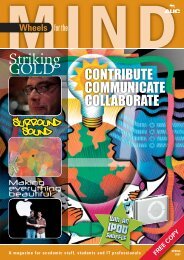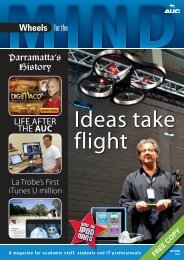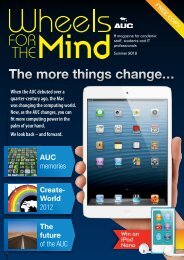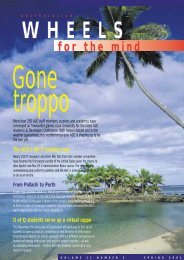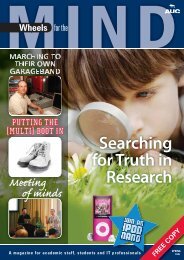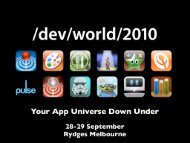for the mind - AUC
for the mind - AUC
for the mind - AUC
You also want an ePaper? Increase the reach of your titles
YUMPU automatically turns print PDFs into web optimized ePapers that Google loves.
Omnium’s Rick Bennet<br />
Omnium<br />
revisits online<br />
learning<br />
By David Braue<br />
University of New South Wales (UNSW)<br />
lecturers are warming to a major<br />
revamp of Omnium, an online learning<br />
and collaboration environment that’s<br />
been built from <strong>the</strong> ground up to<br />
facilitate graphical communication<br />
between designers around <strong>the</strong> world.<br />
Launched in October, Omnium 3.0 builds on three years of work by<br />
Rick Bennett, a lecturer in design at <strong>the</strong> School of Design Studies, within<br />
UNSW’s College of Fine Arts. Bennett founded Omnium Projects in<br />
1999 in an attempt to address perceived shortcomings in previous<br />
‘virtual design studios’ – online services that join participants via <strong>the</strong><br />
Internet.<br />
In its first incarnation, Bennett used <strong>the</strong> Omnium engine to run a tenweek<br />
project called Omnium [vds] ‘99, which linked 50 design students<br />
from 12 countries across five continents. Using feedback and<br />
observations made during that project, Bennett expanded Omnium into<br />
v2.0, which he acknowledges was “a wonderful plan in <strong>the</strong>ory but in<br />
practice it failed <strong>for</strong> a number of reasons – <strong>the</strong> most important of which<br />
is that I failed to remember to keep <strong>the</strong> technology simple and<br />
transparent, so that design activity can be seen clearly.”<br />
With Omnium 3.0, Bennett has been joined by designer/producer<br />
Ouita Broadfoot and programmer/Webmaster Thom McIntyre to<br />
upgrade <strong>the</strong> system, which has been written <strong>for</strong> cross-plat<strong>for</strong>m delivery<br />
using Macs and run off of Mac servers, and has received strong support<br />
from Apple Computer Australia.<br />
The system’s pilot test linked participants in Australia, China,<br />
Singapore, Hong Kong, Brazil, Venezuela, Puerto Rico, Canada,<br />
Germany and South Africa, all of whom used <strong>the</strong> system to attend an<br />
online course called Graphics and Contemporary Society, written by<br />
UNSW design academic Leong K. Chan.<br />
The four-week project, in which participants worked with teams of four<br />
or five to collaboratively develop work that’s available online, concluded<br />
on October 25. Bennett notes that <strong>the</strong> system’s latest incarnation has<br />
begun to attract interest from o<strong>the</strong>r UNSW academics through <strong>the</strong><br />
support of EDTeC, a UNSW centre focused on helping staff make <strong>the</strong><br />
most of online delivery.<br />
With <strong>the</strong>ir guidance, Bennett says Omnium 3.0 has progressed to <strong>the</strong><br />
point where it’s a viable alternative to <strong>the</strong> US-designed WebCT software<br />
that’s become <strong>the</strong> de facto online learning standard <strong>for</strong> Australian<br />
universities. The system is available <strong>for</strong> lease to o<strong>the</strong>r interested<br />
universities around <strong>the</strong> world.<br />
Throughout Omnium’s development, Bennett has had to balance <strong>the</strong><br />
capabilities of technology with <strong>the</strong> features that allow individual<br />
personalities to shine through. “Omnium is specifically designed <strong>for</strong><br />
visual based interaction and places students in working groups to<br />
encourage collaboration,” he says. “Yet no matter how beautiful <strong>the</strong><br />
graphics or how easy <strong>the</strong> interface is to use, <strong>the</strong> personalities of teachers<br />
and students in online learning are always going to be <strong>the</strong> telling factor.”<br />
For more in<strong>for</strong>mation, visit www.omnium.unsw.edu.au or contact<br />
omnium@unsw.edu.au.<br />
Catching some<br />
rays at UTS<br />
It’s always rewarding to see your students rise to <strong>the</strong> pinnacle of<br />
<strong>the</strong>ir chosen careers, but <strong>the</strong> past year has been even more<br />
personally satisfying <strong>for</strong> University of Technology, Sydney<br />
computer graphics lecturer Dr Kevin Suffern.<br />
Suffern, who has taught computer graphics at UTS <strong>for</strong> 20<br />
years, has spent <strong>the</strong> past decade mastering <strong>the</strong> complex process<br />
of ray tracing – modelling <strong>the</strong> flow of light onto, through,<br />
reflecting from and running around simulated three-dimensional<br />
objects. With a background and PhD in applied ma<strong>the</strong>matics,<br />
he has written and refined his own ray tracing software over <strong>the</strong><br />
years, and takes <strong>the</strong> novel approach of having his students write<br />
<strong>the</strong>ir own ray tracers during <strong>the</strong>ir courses.<br />
Recognition of his skill came recently <strong>for</strong> <strong>the</strong> second time in<br />
his career, when his ‘Lighthouse’ received <strong>the</strong> CompuGraph<br />
2002 Bronze award <strong>for</strong> computer art at an awards ceremony<br />
in Singapore. Ano<strong>the</strong>r work, ‘Creation’, was one of 40<br />
shortlisted entries out of more than 200 contenders.<br />
The last time Suffern received an award was <strong>for</strong> a piece he<br />
entered into a 1994 exhibition at ANU’s Drill Hall Gallery,<br />
where he took top prize. This year, he was also invited to<br />
present his work at <strong>the</strong> 17,000 strong SIGGRAPH 2002<br />
conference in Texas, USA.<br />
All have taken with <strong>the</strong>m <strong>the</strong> nuts-and-bolts approach that’s<br />
kept Suffern’s work fresh and well recognised. “I’m not trained<br />
as an artist, but have always been passionate about art – and,<br />
in particular, ray tracing and art. There are very few courses<br />
that teach ray tracing <strong>the</strong> way I teach it – getting students to<br />
write <strong>the</strong>ir own ray tracers from scratch – but <strong>the</strong>y get a proper<br />
understanding of how <strong>the</strong> whole process works.”<br />
The quality of Suffern’s ground-up approach to ray tracing<br />
becomes clear when perusing a list of his previous students.<br />
Notables include Andre Mazzone, whose work at George<br />
Lucas-founded Industrial Light & Magic led to a role in<br />
production of <strong>the</strong> recent movie Ice Age. Justen Marshall and<br />
Naomi Hatchman received Oscars <strong>for</strong> <strong>the</strong>ir work on The Matrix<br />
and are currently working on its upcoming sequel, while Suffern<br />
alumnus Rangi Sutton worked on <strong>the</strong> BBC’s widely lauded<br />
Walking with Dinosaurs and Walking with Beasts.<br />
Suffern’s current students are showing similar promise:<br />
In<strong>for</strong>mation Technology student Steve Agland’s Bin Can Can<br />
work was exhibited at SIGGRAPH 2002 alongside that of his<br />
teacher, while peer Emily Boyd has received a number of<br />
international awards <strong>for</strong> her software MatMice, which has<br />
helped more than 170,000 children worldwide build <strong>the</strong>ir own<br />
Web sites.<br />
Left: Blue, a<br />
recent artwork<br />
Background:<br />
Suffern’s awardwinning<br />
Lighthouse<br />
AUSTRALASIAN WHEELS FOR THE MIND 7



